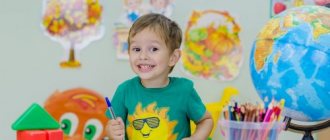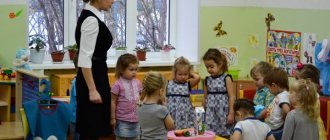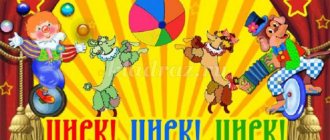Summary of a comprehensive lesson in the second junior group “Let's help Kolobok”
Target:
Develop mental operations, attention, binocular vision; form spatial relationships “above”, “below” .
Continue to learn how to assemble a whole from parts.
Strengthen counting to 5, knowledge of geometric shapes .
Find similarities and differences between objects.
Fixing the color.
Develop children's attention, visual memory, tactile and taste sensations.
Material:
Set of geometric shapes, Kolobok, number cards with geometric shapes, wide and narrow scarves, paints, cut-out pictures, sample, “traffic light”, cards with the image - “House - Kolobok - forest”, “Wonderful bag”, apple, felt-tip pens, paints . An all-terrain vehicle built from chairs.
Progress of the lesson.
Kolobok appears .
The song Kolobok plays (recorded).
Educator: - Kolobok , why are you so sad?
Kolobok: - Help me, please, yesterday I was walking in the forest and lost my scarf.
Educator: - Children, do you want to help Kolobok?
Children: - We want!
Educator: - Before you go on a search, let's draw a route: connect - house - Kolobok - forest in one line, from top to bottom, Kolobok should be on the path. (Cards for each child).
Educator: - Kolobok has brothers, they also rushed to help him. The koloboks rolled and rolled, they hit a stump and fell apart, guys, do you want to help them?
Children: - We want.
Educator: - We need to collect them. (D/i. Fold the picture “Kolobok” according to the model. Cut pictures).
Kolobok helps with the teacher, rejoices at the collected koloboks
Educator: - Let's go on an all-terrain vehicle. Take your tickets (number cards with geometric shapes from 1 to 5), take your seats (numbers from 1 to 5 are pasted on the chairs). Let's check it out.
Educator: - Stop. What is this before us?
Children: - Traffic light.
Educator: - What kind of lights are shining at the traffic lights? What color is the top light? Average? Lower?
Children go out, approach the tables and lay out “Traffic Light” from the circles. Educator: - How many lights?
Children: - Three. Above is red. In the middle is yellow. Below is green.
Physical education lesson “We are drivers.” Green light - drivers drive through the entire group. Red stop. Yellow - getting ready, turning on the engine,
Educator: - We took seats in the “all-terrain vehicle”, according to the ticket and seat number. We approach the forest and go down the hill from top to bottom. Look to the left, how tall the Christmas trees are, and how much snow there is below (we look), also to the right (2 times).
- And how bright the sun is shining, how shiny the snow is - they closed the doors, opened them, blinked (2 times). The sun hid behind a cloud - we opened our eyes. We brake carefully. Let's go out.
There are different scarves on the tables (according to width).
Educator: - Choose the widest (narrow) scarf. How did you know that the scarf is narrow? (wide), apply, compare.
-Paint it with polka dots using any paint of your choice (with your finger).
Children color, select the desired stripe, carry it and give it as a gift.
Kolobok: - Thank you guys, you helped me out, and I prepared a gift for them, but what kind of gift it is, you have to guess.
“Wonderful bag” - children first determine by touch, then smell, taste, and each one says in Kolobok’s ear what is there (an apple).
The children thank Kolobok, he says goodbye and leaves.
Summary of a game lesson in the younger group
Game activity in kindergarten for children of primary preschool age
Theme: Red and blue. Snakes
Demo material:
- toy snake;
- rope in a dark bag;
- a box with objects that are clearly distinguished by their surface: soft fur, a piece of cold leather, rough sandpaper, a soft toy, a wooden tablet, a smooth stone, velvet paper, a piece of silk fabric, rustling tracing paper, etc.;
- audio recording of cheerful music.
Handout:
- for each child, ribbons 15-20 cm long, blue or red;
- plasticine of different colors;
- boards for modeling.
* * *
Organizing time
Meet the children, say hello to each child. Note what color clothes they are wearing.
Physical school
Develops voluntary attention and the ability to imitate the words of a poem.
Together with the children, go through the motions of the poem.
They stomped their feet, they stomp.
They stamped their feet. They stamp their feet.
This is the boot. The legs are put out one by one.
Dance with me, my friend . Spin around.
Surprise moment
Educator
. Guys, do you hear someone hissing: “sh-sh-sh.” Who is this? Snake!
A toy snake crawls into the room. Greets children. You ask the snake if it will bite children. The snake says that it is kind and does not bite anyone. Then the children get to know her.
Sports games with ribbons
Develop basic movements.
Give each child a ribbon (snake). Children repeat the movements after you: lift the ribbon up; They lower them down, spread their arms to the sides, transfer the ribbon from one hand to the other, and spin around with them. Children sit on the floor and show how a snake can crawl along their legs, arms, shoulders, etc.
Educational game “Blue and red ribbons”
Teaches you to distinguish colors and act depending on a given color.
Snake.
Red snakes, climb higher.
Children who have red ribbons raise them up. Then a command sounds for the blue snakes. The game is repeated several times.
Didactic game “Laying out a snake”
Teaches how to apply one object to another, develops fine motor skills of the fingers.
The snake suggests making one long snake from the snakes. Children lay out their snakes one after another. Sports games with rope
Develop basic movements.
The snake quickly collects the resulting long snake from small ribbons and puts it in a bag (which already contains the rope). The snake pretends to cast a spell.
Snake
. Shish-la, shish-la - it turns out to be a snake.
Open the bag and slowly take out the long “snake” (rope).
The rope is laid out on the floor, and children learn to carefully step over it. The rope rises and the children cross over again.
The rope is rolled into a ring, the children jump in and out of the circle.
And finally - tug of war. Divide the children into two teams and explain what to do.
Race walking “Long Snake”
Develops basic movements.
Children hold hands, forming a long snake, and follow you around the room in a circle, every now and then turning in one direction or the other.
Educational game “Long - short snake”
Teaches you to visually understand the words “long - short”.
Children show with their hands the dimensions of a long (spread their arms to the sides) and short (show a small distance between two palms) snake.
Didactic game “Touch the object”
Teaches you to use your fingertips to identify different surfaces by touch and develops tactile sensations.
The snake shows the children its wealth: a box with various objects for touching. She takes out one item at a time.
Snake.
Feel what the rough paper is (hands the velvet paper to the children), touch what the soft toy is, etc.
Outdoor game “Tag with a snake”
Promotes physical activity and relieves impulsiveness, develops gaming skills and arbitrariness of behavior.
Cheerful music is playing, children are running, jumping and having fun. The music stops, the children must squat down and hide (so that the snake does not notice them). A snake crawls past the children. For this game, children will need endurance so as not to run away from the snake.
The game is repeated several times.
Modeling from plasticine “Snakes”
The task involves rolling out long sausages.
The snake offers to make a lot of girlfriends for her - snakes. Children roll a piece of plasticine into a ball, and then into a sausage and give the resulting snake a wave-like shape (they bend the plasticine in several places).
Recommendations for home
Advise parents to look at an album with photographs and videos at home with their child; encourage the child to show people he knows in photographs and videos; Read the fairy tale “Ryaba Hen” several times.
Complex classes in the first junior group
Evgenia Fedorova
Complex classes in the first junior group
Lesson No. 1
Topic: 1. Speech game <<Who is telling?>>
2. Mathematical game <<Find all... >>
Target . 1. Strengthen the child’s ability to distinguish vegetables and fruits by appearance, develop auditory attention.
2. Consolidate knowledge of color, shape, size.
Developmental environment : Models of fruits and vegetables on a tray (apple, cucumber, carrot, etc.) magic multi-colored ropes (strips of adhesive tape 3 mm wide, carpet, geometric shapes
Content.
The teacher shows the children fruits and vegetables, invites them to take one item from the tray and name it: “I have an apple!” I have carrots! I have a big cucumber! And I have a small cucumber!>>
The teacher places one of the children next to him and with his back to the others (Fruits and vegetables are again on the tray). One of the children comes to the table, takes a fruit or vegetable from the tray and says: “I took and am holding an apple in my hand.” Then he puts it on the tray and returns it to its place. <<Guess who held an apple in his hand and told you about it?>>, asks the teacher.
If a child recognizes a friend by voice, everyone claps their hands, and the recognized one takes the place of the driver. If the child makes a mistake, he drives again.
Then the teacher invites the children onto the carpet, marks several circles with multi-colored ropes and says that these are houses in which different figures live. in one of them live large blue figures, and in the other triangular red ones, in the third there are large round figures (objects). Children select the figures and “place” them in the corresponding house (circle). The teacher praises the children and says that the children helped to correctly place all the figures in their homes.
Lesson No. 2
Topic: 1. Speech game <<Captains>>
2. Mathematical game <<What's extra? >>
Target. 1. Develop the ability to pronounce the sound [F] for a long time on one exhalation and repeatedly pronounce the sound [p] (p-p-p) on one exhalation.
2. Learn to identify similarities and differences between objects.
Developmental environment: Bowls of water and paper boats, several small red cubes and one green, one large red cube.
Content.
The children have basins of water and paper boats on their tables. Children sit on chairs and blow on the boats, pronouncing the sound [f] or [p].
The teacher explains that in order for the boat to move, you need to blow slowly, as to pronounce the sound [F], then the boat, with an even wind, moves smoothly and confidently.
“But then a gusty wind came,” says the teacher, “it blows unevenly: <<p-p-p>>
The teacher makes sure that when pronouncing the sounds [F] and [P], the child does not puff out his cheeks, but pronounces the sound [p] 2-3 times in one exhalation.
Finishing the game, the children and teacher sing together:
Wind-breeze,
Pull up the sail!
You drive the boat
To the huge river!
Next, the teacher draws the children’s attention to a large red cube and several small red cubes displayed on the carpet.
Questions.
What's on the carpet?
What color are they?
How many are there?
Which cube do you think is the odd one out? Why? (Big, since he is alone, and the rest are small) Then the teacher invites the children to close their eyes and adds one small


